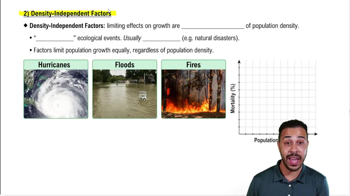Table of contents
- 1. Introduction to Biology2h 42m
- 2. Chemistry3h 40m
- 3. Water1h 26m
- 4. Biomolecules2h 23m
- 5. Cell Components2h 26m
- 6. The Membrane2h 31m
- 7. Energy and Metabolism2h 0m
- 8. Respiration2h 40m
- 9. Photosynthesis2h 49m
- 10. Cell Signaling59m
- 11. Cell Division2h 47m
- 12. Meiosis2h 0m
- 13. Mendelian Genetics4h 44m
- Introduction to Mendel's Experiments7m
- Genotype vs. Phenotype17m
- Punnett Squares13m
- Mendel's Experiments26m
- Mendel's Laws18m
- Monohybrid Crosses19m
- Test Crosses14m
- Dihybrid Crosses20m
- Punnett Square Probability26m
- Incomplete Dominance vs. Codominance20m
- Epistasis7m
- Non-Mendelian Genetics12m
- Pedigrees6m
- Autosomal Inheritance21m
- Sex-Linked Inheritance43m
- X-Inactivation9m
- 14. DNA Synthesis2h 27m
- 15. Gene Expression3h 20m
- 16. Regulation of Expression3h 31m
- Introduction to Regulation of Gene Expression13m
- Prokaryotic Gene Regulation via Operons27m
- The Lac Operon21m
- Glucose's Impact on Lac Operon25m
- The Trp Operon20m
- Review of the Lac Operon & Trp Operon11m
- Introduction to Eukaryotic Gene Regulation9m
- Eukaryotic Chromatin Modifications16m
- Eukaryotic Transcriptional Control22m
- Eukaryotic Post-Transcriptional Regulation28m
- Eukaryotic Post-Translational Regulation13m
- 17. Viruses37m
- 18. Biotechnology2h 58m
- 19. Genomics17m
- 20. Development1h 5m
- 21. Evolution3h 1m
- 22. Evolution of Populations3h 52m
- 23. Speciation1h 37m
- 24. History of Life on Earth2h 6m
- 25. Phylogeny2h 31m
- 26. Prokaryotes4h 59m
- 27. Protists1h 12m
- 28. Plants1h 22m
- 29. Fungi36m
- 30. Overview of Animals34m
- 31. Invertebrates1h 2m
- 32. Vertebrates50m
- 33. Plant Anatomy1h 3m
- 34. Vascular Plant Transport1h 2m
- 35. Soil37m
- 36. Plant Reproduction47m
- 37. Plant Sensation and Response1h 9m
- 38. Animal Form and Function1h 19m
- 39. Digestive System1h 10m
- 40. Circulatory System1h 57m
- 41. Immune System1h 12m
- 42. Osmoregulation and Excretion50m
- 43. Endocrine System1h 4m
- 44. Animal Reproduction1h 2m
- 45. Nervous System1h 55m
- 46. Sensory Systems46m
- 47. Muscle Systems23m
- 48. Ecology3h 11m
- Introduction to Ecology20m
- Biogeography14m
- Earth's Climate Patterns50m
- Introduction to Terrestrial Biomes10m
- Terrestrial Biomes: Near Equator13m
- Terrestrial Biomes: Temperate Regions10m
- Terrestrial Biomes: Northern Regions15m
- Introduction to Aquatic Biomes27m
- Freshwater Aquatic Biomes14m
- Marine Aquatic Biomes13m
- 49. Animal Behavior28m
- 50. Population Ecology3h 41m
- Introduction to Population Ecology28m
- Population Sampling Methods23m
- Life History12m
- Population Demography17m
- Factors Limiting Population Growth14m
- Introduction to Population Growth Models22m
- Linear Population Growth6m
- Exponential Population Growth29m
- Logistic Population Growth32m
- r/K Selection10m
- The Human Population22m
- 51. Community Ecology2h 46m
- Introduction to Community Ecology2m
- Introduction to Community Interactions9m
- Community Interactions: Competition (-/-)38m
- Community Interactions: Exploitation (+/-)23m
- Community Interactions: Mutualism (+/+) & Commensalism (+/0)9m
- Community Structure35m
- Community Dynamics26m
- Geographic Impact on Communities21m
- 52. Ecosystems2h 36m
- 53. Conservation Biology24m
11. Cell Division
Cell Cycle Regulation
Problem 4`
Textbook Question
The decline of MPF activity at the end of mitosis is due to
a. The destruction of the protein kinase Cdk
b. Decreased synthesis of Cdk
c. The degradation of cyclin
d. The accumulation of cyclin
 Verified step by step guidance
Verified step by step guidance1
Understand the role of MPF (Maturation Promoting Factor) in the cell cycle. MPF is a complex of cyclin and Cdk (Cyclin-dependent kinase) that is crucial for the progression of cells from G2 phase to mitosis.
Recognize that MPF activity is regulated by the concentration of cyclin. Cyclin binds to Cdk, activating it, which in turn promotes mitosis.
Identify that at the end of mitosis, MPF activity must decline to allow the cell to exit mitosis and enter the next phase of the cell cycle.
Learn that the decline in MPF activity is primarily due to the degradation of cyclin. Cyclin is tagged for destruction by ubiquitination, leading to its breakdown by proteasomes.
Conclude that the degradation of cyclin results in the inactivation of Cdk, as Cdk requires cyclin to be active. Therefore, the correct answer is related to the degradation of cyclin.
 Verified video answer for a similar problem:
Verified video answer for a similar problem:This video solution was recommended by our tutors as helpful for the problem above
Video duration:
51sPlay a video:
Was this helpful?
Key Concepts
Here are the essential concepts you must grasp in order to answer the question correctly.
MPF (Maturation Promoting Factor)
MPF is a complex of cyclin and cyclin-dependent kinase (Cdk) that plays a crucial role in regulating the cell cycle, particularly the transition from G2 phase to mitosis. Its activity is essential for the initiation of mitosis, and it is regulated by the levels of cyclin and the phosphorylation state of Cdk.
Recommended video:
Guided course

Density-Independent Factors
Cyclin
Cyclins are proteins that control the progression of cells through the cell cycle by activating Cdks. Cyclin levels fluctuate throughout the cell cycle, with specific cyclins being synthesized and degraded at different stages, which in turn regulates the activity of Cdks and the timing of cell cycle events.
Cyclin Degradation
The degradation of cyclin is a key mechanism for regulating MPF activity. At the end of mitosis, cyclin is targeted for degradation by the ubiquitin-proteasome pathway, leading to a decrease in MPF activity. This degradation is crucial for the exit from mitosis and the transition to the next phase of the cell cycle.
Recommended video:
Guided course

Habitat Destruction and Degradation
Related Videos
Related Practice










![The Cell Cycle (and cancer) [Updated]](https://img.youtube.com/vi/QVCjdNxJreE/mqdefault.jpg)